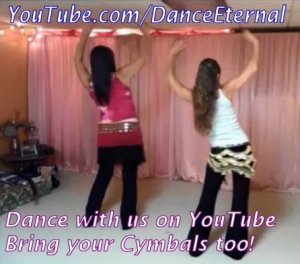After teaching belly dance for over 20 years, I’ve found that DRILLS are a priceless tool for teaching. They’re not only a fast way for students to create muscle memory during movements, but students also seem to feel more comfortable asking for clarification during this part of class time.
I actually use two types of class activities when teaching Tribal Odyssey:
1. Drills: a focused exercise emphasizing a particular movement combination, transition between combinations, or a concept such as lead-throwing or changing formations.
2. Dancing a Complete Song or Set: this activity emphasizes the performance aspect of dancing together. The class can “enter” the performance space, and dance through the ending of a song or several songs without stopping.
For both activities I try to use music that emphasizes the relevant beats, like chifti-telli (when they hear “5, 6, 7″ they know it’s time for a cue); or beledi (they will be on the RIGHT foot when they hear the two heavy beats [except for the Slow Hip Circle]). And especially for new students, or Level One in general, I help them hear these beats by listening to the music before starting. That REALLY helps!
My book “Guide to Teaching Middle Eastern Dance” has more on developing your own teaching method – it’s written for belly dance teachers in general but applies to group improv teachers too. If you’re interested in learning more about teaching methods and planning classes, here’s the link to the Guide to Teaching on my website. (However, for TOBD group improv format in particular, there’s a separate book available on the TObellydance.com site.)
Teaching Tribal Improv opens up many new topics for Drills in class. Sometimes we do “Cue Drills”, for instance we’ll alternate between two specific combinations, focusing on the transition in between – specifically, the cue from one to the other combination. Or we’ll only focus on Circle Travel combinations, or Lead-throwing combinations, the combinations that include optional turns, etc.
Or sometimes we do “Staging Drills”, using only one or at most, two combinations, while we flow through all the group formations. This is great for having the students develop awareness of the group as a unit; dancing as part of a larger entity in unison; keeping their individual spacing nice, adjusting their own positions in the line, etc.
Or we’ll do “Ending Drills” – while the class is dancing I’ll fade out the music unexpectedly to see the students initiate and complete one of our Endings.
During drills, teachers should just watch – instead of participating; that way they can offer corrections and suggestions, and take notes on what needs further review.
Drills really do help to clear up a lot of misunderstandings students have, and I believe that helps them enjoy the process of learning – and dancing – even more.
by Anthea (Kawakib)
– end of post –



You must be logged in to post a comment.